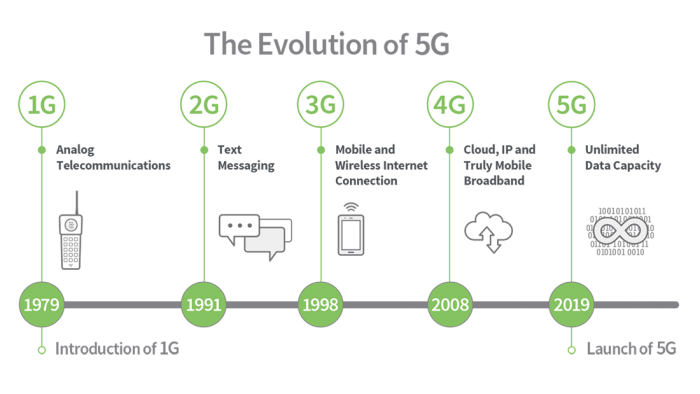When selecting technology for IoT deployments, enterprises need to know how long 4G LTE will be available, whether 5G will make 4G obsolete, and how to plan their investment. The answer is that there will be a long period of time when 4G and 5G will co-exist. LTE, which stands for Long Term Evolution, will be around for at least 10 years, so 5G will not make LTE obsolete any time soon.
Having put our fears to rest that 5G will make 4G obsolete, how do you choose where to invest? LTE technology is stable and will be available long term, and 5G is exciting and emerging. Let's talk about some of the benefits we will see with 5G and other key considerations as you plan your
5G journey.
4G or 5G: How to Choose?
The arrival of 5G — the next generation of cellular technology — means that not only will more devices be connected to the Internet of Things, but also that those devices will be better connected, with higher data transmission speeds, lower latency and lower power requirements. All of this will produce more efficient and more profitable business solutions than are possible today.
Given those advantages, some might assume that every new IoT project should be based on 5G. While it’s true that some 5G IoT use cases are only possible with 5G, many others can work just as well and at significantly lower cost with current 4G LTE technology which, as we've discussed, will be supported in the industry for at least another decade.
Choosing between 4G LTE and 5G means examining both the technical and business aspects of any new project and projecting the long term costs and benefits of either direction. To support your decision-making, we’ll consider the benefits of 4G LTE, its projected lifespan and how and when making the leap to 5G makes sense.
What’s the Lifespan of a G?
 What is the lifespan of a network generation? Good question. Broadly speaking, a new generation (or “G”) of cellular technology comes along every 10 years. Looking back, the last two cellular technologies have had a multi-decade lifespan from first release to sunset:
What is the lifespan of a network generation? Good question. Broadly speaking, a new generation (or “G”) of cellular technology comes along every 10 years. Looking back, the last two cellular technologies have had a multi-decade lifespan from first release to sunset:
- 2G: 1990-2020, 30 years+
- 3G: 2000-2020, 20 years+
- 4G: 2008+
Why do the older technologies such as 2G and 3G need to sunset? The reason for this is that the amount of available spectrum is limited. The same spectrum that has been used for 2G and 3G can now be re-used for 4G LTE to deliver more data at higher speeds.
Our current generation of cellular technology, 4G LTE, was introduced in 2008 with Release 8 by the 3rd Generation Partnership Project (3GPP), which is an organization that develops standards for mobile communications. The 3GPP issues standard releases with incremental improvements about every other year (up to Release 14) and guides the evolution of the 4G standard.
4G LTE (Long Term Evolution) is a technology that has now been proven in both consumer and commercial applications. 4G LTE is flexible. It accommodates, for example, low-power LTE-M and NB-IoT devices that typically transmit only a few KBs of data, as well as devices capable of high-speed Gigabit data transmission. Because of its widespread adoption, 4G LTE is also very affordable, especially compared to the cost of the newest, high-end 5G technology, which earns the term “bleeding edge” in terms of cost and capabilities, as well as support.
Download our Solution Brief
Move boldly ahead to the fifth generation cellular standard with Digi International.
Download PDF
The Transition from 4G to 5G
With the exponential growth of IoT devices in recent years and the aforementioned limited spectrum, the lifespan of cellular technology is getting shorter. 2G and 3G have been sunsetted to make room for the more spectrum-efficient 4G LTE and emerging 5G technologies. 4G is expected to last for at least another decade, and possibly longer with the help of Dynamic Spectrum Sharing (DSS), which shares available spectrum between 4G LTE and 5G devices. DSS provides improved coverage for 5G devices and greater longevity for 4G LTE devices. The first 4G LTE sunset announcements are expected after 2030, which means that companies can safely invest in 4G-based IoT solutions today and for the foreseeable future.

To make 5G technology available early and provide a seamless user experience, first 5G networks and devices will work in non-standalone (NSA) mode, which means that a device will always connect to the 4G LTE network first, and if a 5G network becomes available, the device will use 5G for additional bandwidth. So for example, a 5G NSA device may use 400 Mbps of bandwidth over 4G LTE and another 200 Mbps over 5G, with an aggregate of 600 Mbps, which together is faster than 4G and 5G alone.
Over the next several years, network infrastructure will evolve to enable 5G-only stand-alone mode (SA). This will bring the low latency and ability to connect with massive numbers of IoT devices that are among the primary advantages of 5G.
Comparing IoT Use Cases for 4G LTE and 5G
The speed and throughput of 4G LTE is more than adequate for a wide range of use cases. But as technology advances, new applications and use cases for 5G are emerging. Indeed, there are applications that are only possible with 5G’s speed and low latency.

Let’s consider three commercial examples where the 4G LTE to 5G transition will play out.
- Traffic: Autonomous vehicles need the extremely low latency of 5G with response times measured in milliseconds. Only 5G is capable of that. But 4G LTE speeds are sufficient for most traffic-related functions, even routing first responder vehicles in an emergency. A good example is the 4G LTE-based, FirstNet™ Ready Digi WR54, which has capabilities for signal timing and traffic management in emergency response situations. In some traffic-related use cases such as data gathering for traffic counts, data could be collected just once a day, making latency a non-issue.
- Industrial Internet of Things (IIoT): Industrial automation will be greatly enhanced with 5G. Robotic controls that currently require the use of cables because of the limited range and the latency of today’s cellular technology could go fully wireless with 5G, enabling more flexible and efficient factories. An example in a more passive industrial setting would be a sensor measuring the fuel level in a remotely situated fuel tank. This use case would also require wireless because of the remote location. But because only a small amount of data is being transmitted periodically, a battery-powered 4G LTE-M or NB-IoT device is sufficient.
- Drones: 5G promises to extend the capabilities of IoT drones by enabling a controller wearing 5G Augmented Reality (AR) goggles to see beyond current line-of-sight limits with low latency and high resolution video. Drones using existing wireless technology, however, are currently operating in diverse use cases such as search and rescue, crime scene investigation and increasingly in package delivery.
Final Considerations: 4G vs. 5G
Instead of waiting for the full 5G rollout, organizations can start building for the future now with 4G LTE technology and validate their applications and business models. They can then refine and expand when 5G becomes more widely available and cost-effective. Fortunately, there is no danger of 4G LTE becoming unavailable for at least a decade. Nevertheless, there are use cases where 5G is a more desirable choice, and those are some of the top candidates for adopting the bleeding edge.
 At the low end, with LTE-M and NB-IoT, as well as in the mid-tier with cellular speeds below 1 Gbps, 4G LTE is clearly the winner in terms of cost, coverage, and availability. When we look at the high-end with cellular speeds beyond 1 Gbps, 5G may become more appealing, but at a premium. A thoughtful upgrade strategy will save money and headaches.
At the low end, with LTE-M and NB-IoT, as well as in the mid-tier with cellular speeds below 1 Gbps, 4G LTE is clearly the winner in terms of cost, coverage, and availability. When we look at the high-end with cellular speeds beyond 1 Gbps, 5G may become more appealing, but at a premium. A thoughtful upgrade strategy will save money and headaches.
Positioned as we are, at the point where 5G technology is just starting to become generally available, there are some key considerations and trade-offs as you decide which direction to go with your IoT project. Given the complexity, it's important to work with a knowledgeable solution provider. A good partner can guide you in choosing the right technology for your use case and ensure that you are investing in technology that supports your long-term business goals.
Reach out to discuss your next IoT project and the best technology choice to make it a success.
Next Steps